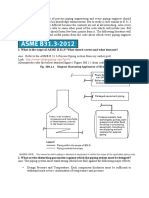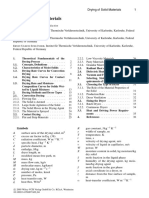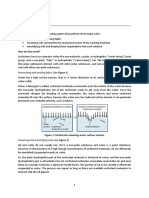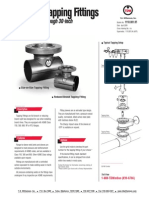Questions For Stress Analysis
Questions For Stress Analysis
Uploaded by
Sunday PaulCopyright:
Available Formats
Questions For Stress Analysis
Questions For Stress Analysis
Uploaded by
Sunday PaulOriginal Title
Copyright
Available Formats
Share this document
Did you find this document useful?
Is this content inappropriate?
Copyright:
Available Formats
Questions For Stress Analysis
Questions For Stress Analysis
Uploaded by
Sunday PaulCopyright:
Available Formats
Sample questions on piping stress analysis By S Koley, QEI-Piping Technical Knowledge: Q1. What is primary and secondary stress?
What are the code allowable stresses per B31.3? ANS: Primary stresses which are developed by the imposed loading are necessary to satisfy the equilibrium between external and
internal forces and moments of the piping system. Primary stresses are not self-limiting. Therefore, if a primary stress exceeds the yield strength of the material through the entire cross section of the piping, then failure can be prevented only by strain hardening in the material. Secondary stresses are developed by the constraint of displacements of a structure. These displacements can be caused either by thermal expansion or by outwardly imposed restraint and anchor point movements. Under this loading condition, the piping system must satisfy an imposed strain pattern rather than be in equilibrium with imposed forces. Local yielding and minor distortions of the piping system tend to relieve these stresses. Therefore, secondary stresses are self-limiting. Limit of Primary Stresses. The sum of the longitudinal stresses SL due to pressure, weight, and other sustained loads must not exceed Sh (basic allowable stress at maximum metal temperature). The thickness of pipe used in calculating SL shall be the nominal thickness minus mechanical, corrosion, and corrosion allowances. Limit of Secondary Stress range. The displacement stress range SE shall not exceed SA SA= allowable displacement stress range = f(1.25Sc + 0.25Sh) = f[1.25(Sc + Sh) - SL] when Sh > SL Sc = basic allowable stress at minimum metal temperature, psi f = stress range reduction factor per Table B4.2
Q2. Why and where Spring support is used in piping system? Is it used to lower the thermal stress in the system? ANS: In piping system when pipe lifts from its one support point due to thermal expansion then total dead weight is redistributed on the other supports or at connecting nozzle point. To reduce that nozzle load we use spring support at that lift-off support location to take the hot dead load of the piping. No. It may increase/decrease system stress depending upon the routing of the piping system. Q3. From where we get allowable loads for Centrifugal pump nozzles? Why suction and discharge nozzle loads both needs to satisfy the API-610 requirement to safe guard the pump? Ans: Allowable loads for the centrifugal pump are taken from API-610 STD table-4. To safe guard the pumps, two effects on nozzle loads are considered (Per API-610) a) Distortion of the pump casing. (Bending of casing due to equivalent loads and moments) b) Misalignment of the pump and driver shafts (leads to enormous wear between rotating and static part) So value and point of act of Equivalent loads (combining the piping loads at suction and discharge nozzle) are the governing parameter for pump design. That why both suction and discharge nozzle loads simultaneously needs to under allowable limit. Q4. What is the basic difference between WRC-107 and WRC-297 Ans: Both are used to calculate local stress with some limitations as below: For WRC 297: a) d/D <= 0.5 Where D=OD of vessel, T=thickness of vessel b) ) D/T<=2500 d= OD of nozzle, t= thickness of nozzle c) d/t <=100 d) Calculates vessel stress and nozzle stress, e) Used for cylindrical nozzle on cylindrical vessel For of WRC 107 a) d/D < 0.33 b ) Dm/T>50, where Dm = D T, mean vessel dia. c) Calculates vessel stress only.
Sample questions on piping stress analysis By S Koley, QEI-Piping
Practical Knowledge: Q1. For column piping (connected at top and coming down to ground to control station) where you place spring support? And why? Ans: Spring support is taken at the vertical leg near to the elbow at top if rigid rest support is inactive or semi-active at that point and spring should be taken from Column shell so as to minimize the differential thermal movement between pipe and shell. There are two common behavior observed in column piping : If column temperature is higher than connected piping: Due to the higher temperature of the column, vertical upwards movement of Support-Shell junction point for support taken from Column Shell is higher than the point of support on pipe. So column will push the pipe on upward direction. Again vertical upwards movement of the column from Support-Shell junction point to Nozzle point is greater than the vertical upwards movement of pipe form Support point to nozzle point. So Column is pulling the pipe in expansion case. The support on pipe will lift depending on the combination effect of these Push-Pull events. This is a common behavior of the column piping. Sometimes support is not lifting but releasing some percentage of dead load in expansion case and this load is accumulating on the nozzle which leads to high nozzle load in vertical forces and longitudinal moments. By using spring support at that point Push-Pull event is minimized and nozzle loads are drastically lowered. If column temperature is lower than connected piping: Due to the lower temperature of the column, vertical upwards movement of Support-Shell junction point for support taken from Column Shell is lower than the point of support on pipe. So support at pipe will lift from its point. Again vertical upwards movement of the column from Support-Shell junction point to Nozzle point is lower than the vertical upwards movement of pipe form Support point to nozzle point. So Column will restrict the upwards movement of pipe in expansion case and the thermal growth will flow towards the down and it will try to put back the support at its point. The support on pipe will lift depending on the combination effect of these Push-Pull events. Sometimes support is not lifting but releasing some percentage of dead load in expansion case and this load is accumulating on the nozzle which leads to high nozzle load in vertical forces and longitudinal moments. By using spring support at that point Push-Pull event is minimized and nozzle loads are drastically lowered. Q2. How a control valve assembly is supported and why? Ans: In a control valve assembly kinetic parameters of the fluid are controlled and due to that the whole assembly is very susceptible to vibration which adversely effects on the accuracy of the controlling. To minimize the vibration amplitude a 3-directional translational stop at the upstream elbow with trunnion and a guided rest support at downstream elbow with trunnion are considered to support the whole assembly. Sometimes additional rest support is required between the elbow to carry actuator weight for heavier control valves. Q3. What is the objective of stress analysis? Ans: 1. To ensure that the stresses in piping components in the system are within allowable limits. 2. To solve dynamic problems developed due to mechanical vibration, fluid hammer, pulsation, relief valves, etc 3. To solve problems associated due to higher or lower operating temperature such as a) Displacement stress range b) Nozzle loading on connected equipments c) Pipe displacements d) Loads & moments on supporting structure. Q4. What are the steps involved in stress analysis (or any stress package carries out)? Ans : 1. Identify the potential loads that the piping system would encounter during the life of the plant. 2. Relate each of these loads to the stresses and strains developed. 3. Get the cumulative effect of the potential loads in the system. 4. Decide the allowable limits the system can withstand without failure as per code. 5. After the system is designed to ensure that the stresses are within safe limits. 6. Ensure the loads at different restraint and nozzle/Tie-in points are within reasonable range. Q5. What is desired life cycle for Piping in operation? Ans: Desired life cycle for Piping in operation is 20 Years. Assuming one cycle per day, the normal no. of cycles for which the displacement or thermal stresses are designed is = 30 (day)x 12 (month)x 20 (years) = 7200 cycles ~7000 cycles.
Sample questions on piping stress analysis By S Koley, QEI-Piping Software Knowledge: Q1. How do you calculate the operating load with WIND Loads ? (Only mention the load cases.)
Ans:
1. W+P1+T1+H+WIN1 2. W+P1+T1+H+WIN2 3. W+P1+T1+H+WIN3 4. W+P1+T1+H+WIN4 Where W = Dead Weight of the piping system with fluid and insulation. P1= Internal pressure T1= Temperature H = Hanger load at T1 operating case(If have) WIN1/2/3/4= Wind force towards (+X)/(-X)/(+Z)/(-Z) directions respectively.(assuming +Y is vertical) Q2. What is ESL data? Ans: The ESL Menu gives access to utilities which interact with the External Software Lock. Show DataDisplays data stored on the ESL. ESL is used at the time of changing/opening/saving/Running of any module in CAESAR-II. Q3. How thermal movements (say for equipment nozzle) at any point are fed in CAESAR-II? Ans: This auxiliary screen Displacement is used to enter imposed displacements at up to two nodes per spreadsheet. Up to nine displacement vectors may be entered (load components D1 through D9). If a displacement value is entered for any vector, this direction is considered to be fixed for any other non-specified vectors. Leaving a direction blank for all nine vectors models the system as being free to move in that direction. Specifying 0.0 implies that the system is fully restrained in that direction. Q4. What is Kaux menu? Ans: The Kaux menu provides some miscellaneous items. Review SIFs at Intersection NodesAllows the user to run what if tests on the Stress Intensification Factors of intersections. Review SIFs at Bend NodesAllows the user to run what if tests on the Stress Intensification Factors of selected bends. Special Execution ParametersAllows the user to set options affecting the analysis of the current job. Items covered include ambient temperature, pressure stiffening, displacements due to pressure (Bourdon effect), Z-axis orientation, uniform loads in gs, etc.
You might also like
- Wheel Wiring Schematic Deutz EngineDocument1 pageWheel Wiring Schematic Deutz EngineRex Sanchez50% (4)
- Fatigue Analysis of Piping System Using Caesar IIDocument9 pagesFatigue Analysis of Piping System Using Caesar IIHmd Mokhtari100% (2)
- FPSO - Load Cases (100 Yr)Document3 pagesFPSO - Load Cases (100 Yr)iaftNo ratings yet
- Basic Load Cases Used For Piping Stress Analysis PDFDocument10 pagesBasic Load Cases Used For Piping Stress Analysis PDFzafarbadalNo ratings yet
- Jacketed Piping Stress Analysis - HP 1978 PDFDocument3 pagesJacketed Piping Stress Analysis - HP 1978 PDFim4uim4uim4uim4u100% (1)
- 11 Most Important Questions & Answers From ASME B 31.3 Which A Piping Stress Engineer Must KnowDocument6 pages11 Most Important Questions & Answers From ASME B 31.3 Which A Piping Stress Engineer Must KnowRakesh RanjanNo ratings yet
- Pipe Stress Manual CalcDocument62 pagesPipe Stress Manual CalcEsapermana Riyan100% (2)
- Module 05 Piping Stress Analysis Pravin JedheDocument15 pagesModule 05 Piping Stress Analysis Pravin JedheAbdul Tayyeb100% (2)
- Pipe Stress Manual CalcDocument62 pagesPipe Stress Manual Calcpipestress100% (9)
- Api 1104 Acceptance CriteriaDocument6 pagesApi 1104 Acceptance CriteriaWillykateKairu75% (4)
- ORIFICEDocument1 pageORIFICEhardavNo ratings yet
- Must Have Load Cases For Stress Analysis of A Typical Piping System Using Caesar IIDocument4 pagesMust Have Load Cases For Stress Analysis of A Typical Piping System Using Caesar IIKaliya Perumal100% (3)
- Zinq - AnalysisDocument116 pagesZinq - AnalysisAimiNo ratings yet
- Pipe Stress Analysis Using CAESAR IIDocument42 pagesPipe Stress Analysis Using CAESAR IIpca97100% (1)
- Points To Be Considered During Stress AnalysisDocument24 pagesPoints To Be Considered During Stress Analysismishtinil100% (1)
- Slug Flow Analysis Using Dynamic Spectrum Method in Caesar II Part 2 of 2Document4 pagesSlug Flow Analysis Using Dynamic Spectrum Method in Caesar II Part 2 of 2Romner Cordova100% (2)
- Hot Sustained Load Case CaesarIIDocument6 pagesHot Sustained Load Case CaesarIIshaffeti100% (1)
- Fatigue Analysis Using CAESAR IIDocument7 pagesFatigue Analysis Using CAESAR IIayounga100% (1)
- Alignment Check Methodology in Piping Stress Analysis Using Caesar IIDocument2 pagesAlignment Check Methodology in Piping Stress Analysis Using Caesar IIYoesbar Sofyan100% (1)
- Dynamic Analysis of PipeDocument11 pagesDynamic Analysis of PipeAshok KsNo ratings yet
- Load Cases For Typical Piping System Using CAESAR IIDocument4 pagesLoad Cases For Typical Piping System Using CAESAR IIsj22100% (1)
- Slug Flow Analysis Using Dynamic Spectrum Method in Caesar IIDocument7 pagesSlug Flow Analysis Using Dynamic Spectrum Method in Caesar IIJ A S JAS100% (1)
- Jacketed PipingDocument4 pagesJacketed Pipingbinukumar100100% (1)
- Pipe Stress AnalysisDocument15 pagesPipe Stress Analysispvmsson100% (1)
- Bourdon Effect in CAESAR II: Intergraph CASDocument3 pagesBourdon Effect in CAESAR II: Intergraph CASAnonymous Iev5ggSR100% (2)
- Fatigue Analysis W - CIIDocument10 pagesFatigue Analysis W - CIInaeand100% (1)
- Work Instruction - Expansion Joint Modelling in CAESAR IIDocument11 pagesWork Instruction - Expansion Joint Modelling in CAESAR IIChanNo ratings yet
- Modeling Procedure of Rigid Strut in Caesar IIDocument5 pagesModeling Procedure of Rigid Strut in Caesar IIHmd MokhtariNo ratings yet
- Spring Support Used in PipingDocument7 pagesSpring Support Used in Pipingashish.mathur1No ratings yet
- Pipe Stress Analysis Case Study - Pump Discharge - Piping Technology & Products, IncDocument10 pagesPipe Stress Analysis Case Study - Pump Discharge - Piping Technology & Products, Inckaliya12100% (1)
- Spring PPT 2012Document28 pagesSpring PPT 2012ashu23283100% (2)
- Harmonic Analysis REV. 1Document7 pagesHarmonic Analysis REV. 1Amro SalahNo ratings yet
- Algebraic and ScalarDocument4 pagesAlgebraic and Scalardtr17No ratings yet
- Stress Analysis Report FormatDocument9 pagesStress Analysis Report FormatPinak Projects100% (3)
- Screenshots of Pipe Stress Analysis in ActionDocument17 pagesScreenshots of Pipe Stress Analysis in ActionCepi Sindang Kamulan100% (3)
- Modeling of Internal Pressure and Thrust Load On Nozzles Using WRC 368Document5 pagesModeling of Internal Pressure and Thrust Load On Nozzles Using WRC 368m5416No ratings yet
- Example From Theory To Caesar II PDFDocument12 pagesExample From Theory To Caesar II PDFIskandar Hasibuan100% (1)
- StressDocument158 pagesStressSapana Malla100% (1)
- Load Case CAESAR IIDocument6 pagesLoad Case CAESAR IIshakasspNo ratings yet
- Stress Analysis 1Document82 pagesStress Analysis 1Luis Ortiz100% (10)
- Procedure For Pump Line Stress AnalysisDocument9 pagesProcedure For Pump Line Stress AnalysisNilesh Gohel100% (1)
- Air Cooler Piping Stress Analysis Using Caesar IIDocument5 pagesAir Cooler Piping Stress Analysis Using Caesar IIsemin prsesNo ratings yet
- Piping Stress - Ysis-EnDocument98 pagesPiping Stress - Ysis-EnArash Aghagol100% (1)
- Column Piping Stress AnalysisDocument6 pagesColumn Piping Stress Analysissj22100% (2)
- GRP Pipe Analysis - Write Up - 1Document8 pagesGRP Pipe Analysis - Write Up - 1Marie SaundersNo ratings yet
- Procedure of Turbine Modeling: Load If Given by The VendorDocument5 pagesProcedure of Turbine Modeling: Load If Given by The Vendorsantosh_ms_kumar2827100% (1)
- Basics of Pipe StressDocument32 pagesBasics of Pipe Stressrajuksk_pipingNo ratings yet
- Sifs and Orientations in Caesar Ii: Figure 1 - Standard and "Advanced" Branch Connection ModelsDocument12 pagesSifs and Orientations in Caesar Ii: Figure 1 - Standard and "Advanced" Branch Connection Modelsral75100% (1)
- CAESAR II - Ver 7.0 Class NoteDocument50 pagesCAESAR II - Ver 7.0 Class NoteAnonymous 9fNuCpaO8100% (4)
- Dynamic Load in Piping SystemDocument3 pagesDynamic Load in Piping SystemAMITDEWANGAN1991100% (1)
- Procedure For Column Line Stress AnalysisDocument6 pagesProcedure For Column Line Stress AnalysisNilesh Gohel100% (1)
- CAESAR-II Output ReportDocument37 pagesCAESAR-II Output ReportSaima Saima100% (1)
- Dynamic Module of CAESAR II PDFDocument68 pagesDynamic Module of CAESAR II PDFPrashant Agrawal100% (3)
- 1.fpso Stress AnalysisDocument2 pages1.fpso Stress AnalysisSundeepGuptaNo ratings yet
- Stress QuizDocument8 pagesStress QuizNagarjuna Seella100% (1)
- Pipe Stress QuestionsDocument2 pagesPipe Stress Questionssj22No ratings yet
- How Do You Carry Out Estimation? Ans: 1. Input From BidDocument21 pagesHow Do You Carry Out Estimation? Ans: 1. Input From BidSunil ShaNo ratings yet
- Selection Criteria For Lines Subject To Comprehensive Stress AnalysisDocument10 pagesSelection Criteria For Lines Subject To Comprehensive Stress AnalysisNithin Zs100% (1)
- Basic Pipe Stress Analysis TutorialDocument34 pagesBasic Pipe Stress Analysis TutorialCüneyt Gökhan Tosun100% (1)
- Piping System Using Caesar IIDocument16 pagesPiping System Using Caesar IIPrakash100% (1)
- Manual CAEPipeDocument47 pagesManual CAEPipeClaudio GimenezNo ratings yet
- Stress AnalysisDocument60 pagesStress AnalysisTejas DesaiNo ratings yet
- C-27 Piping Flexibility AnalysisDocument32 pagesC-27 Piping Flexibility AnalysisChuy Lee100% (1)
- B31.4 Calculator Ver 1Document88 pagesB31.4 Calculator Ver 1Sunday Paul100% (2)
- Offcon DNV Zorro SkidDocument6 pagesOffcon DNV Zorro SkiddakidofdaboomNo ratings yet
- Offcon DNV Zorro SkidDocument6 pagesOffcon DNV Zorro SkiddakidofdaboomNo ratings yet
- Piping Design AidsDocument248 pagesPiping Design AidsSunday PaulNo ratings yet
- Spray Drying TheoryDocument36 pagesSpray Drying TheorySunday PaulNo ratings yet
- Dryiig DataDocument3 pagesDryiig DataSunday PaulNo ratings yet
- Journal Pone 0074403 s001Document3 pagesJournal Pone 0074403 s001Sunday PaulNo ratings yet
- Spray Dryer DesignDocument38 pagesSpray Dryer DesignSunday PaulNo ratings yet
- Questions API 1104 Initial - 001Document3 pagesQuestions API 1104 Initial - 001Sunday Paul100% (1)
- Guidelines For User Acceptance TestingDocument11 pagesGuidelines For User Acceptance TestingSunday Paul100% (1)
- Urfactants: What Do They Do?Document1 pageUrfactants: What Do They Do?Sunday PaulNo ratings yet
- Dimesiones Tee's EnvolventeDocument4 pagesDimesiones Tee's EnvolventeJuan Carlos Dominguez Bta0% (1)
- Draft India - DCS - NationalStudy - Peer Review FinalDocument65 pagesDraft India - DCS - NationalStudy - Peer Review FinalVikram MurthyNo ratings yet
- Overcurrent Coordination Basics ConductorsDocument7 pagesOvercurrent Coordination Basics ConductorsrobertoseniorNo ratings yet
- Product Data Sheet: ARA Auto Recloser Aux For Ic60 1P-1PN-2P - 4 ProgDocument2 pagesProduct Data Sheet: ARA Auto Recloser Aux For Ic60 1P-1PN-2P - 4 ProgYouwan LeeNo ratings yet
- Tropical Architecture: Basic Design PrinciplesDocument27 pagesTropical Architecture: Basic Design PrinciplesChristian Villena100% (3)
- Physical SecurityDocument20 pagesPhysical SecurityJudielyn CualbarNo ratings yet
- Motor V3800Document2 pagesMotor V3800ANGELA ARDILANo ratings yet
- Led Lighting Is ThornDocument88 pagesLed Lighting Is ThornhansdubarryNo ratings yet
- JSW Mail - Re - Requirement of General Battery Sets For Wuhu VesselsDocument7 pagesJSW Mail - Re - Requirement of General Battery Sets For Wuhu VesselsRahul KumarNo ratings yet
- ABB String Product Manual - DC Counter Part TypesDocument1 pageABB String Product Manual - DC Counter Part TypesSemih HürmeydanNo ratings yet
- Balanced Modulator Using DiodesDocument5 pagesBalanced Modulator Using DiodesJasdeep SinghNo ratings yet
- Glossary of TermsDocument6 pagesGlossary of TermstinguiblueNo ratings yet
- 02 Daikin Paquete 5 TRDocument36 pages02 Daikin Paquete 5 TRAllan Habbyb Ortiz RuizNo ratings yet
- Electric Drive Truck: Gross Horsepower Nominal GVWDocument16 pagesElectric Drive Truck: Gross Horsepower Nominal GVWRaúl Rosalino Pérez GómezNo ratings yet
- BSD 323 Module 04Document19 pagesBSD 323 Module 04Dizon, Sean Andrei S.No ratings yet
- Network Reconfiguration For Load Balancing in Distribution System With Distributed Generation and Capacitor PlacementDocument6 pagesNetwork Reconfiguration For Load Balancing in Distribution System With Distributed Generation and Capacitor PlacementDanish KhanNo ratings yet
- Chennai Central Railway StationDocument4 pagesChennai Central Railway StationThe United IndianNo ratings yet
- Fluid:: - Density (Document43 pagesFluid:: - Density (Ayush SrivastavNo ratings yet
- Ecosystems Chapter - 3Document46 pagesEcosystems Chapter - 3Vishwa Pratap Singh100% (1)
- FEM PresentationDocument75 pagesFEM PresentationGooftilaaAniJiraachuunkooYesusiinNo ratings yet
- Tank System Integrated Model: A Cryogenic Tank Performance Prediction ProgramDocument144 pagesTank System Integrated Model: A Cryogenic Tank Performance Prediction ProgramnamrtaNo ratings yet
- Dust Cleaning Blower Technical specification-REVISEDDocument3 pagesDust Cleaning Blower Technical specification-REVISEDSolomon AmanteNo ratings yet
- O' Level Physics Revision Thermal PhysicsDocument4 pagesO' Level Physics Revision Thermal Physicsjumaa12345No ratings yet
- Skin EffectDocument3 pagesSkin EffectHans De Keulenaer100% (1)
- A THEORY of The Univers..Document13 pagesA THEORY of The Univers..Che Iglesia JardineroNo ratings yet
- Spark Plug ReadingDocument7 pagesSpark Plug ReadingCostas GeorgatosNo ratings yet
- RTAF - Air-Cooled Series R (TM) Product ReportDocument2 pagesRTAF - Air-Cooled Series R (TM) Product ReportRafaelDutraNo ratings yet
- Double Pipe Heat ExchangerDocument21 pagesDouble Pipe Heat ExchangerIsabel GarciaNo ratings yet
- Cacao ShellerDocument3 pagesCacao ShellerZera MenmaNo ratings yet





































































































